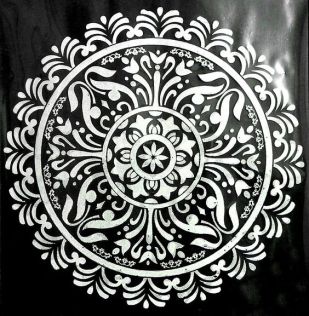
Us humans… well, most of us, have something or the other that we are quite fond of. It might be anything from music to painting, History to Mathematics and everything in between. Some are inspired by their fondness, perceiving it as a calling of sorts, to the level where they pursue it actively as a hobby, or better, a profession.
Some others are also there, like me, who couldn’t or didn’t, make a headway in their preferred fields but still persistently try to seek solace in it. Why? Maybe because, it reminds them of their original interest, maybe because it transports them to some long forgotten happy place…

One such liking of mine is that of Alpona. An ancient art form originating in Bengal (India), Alpona or Alpana is primarily associated with ceremonial and religious rituals. It is held in high regard in Bengal. Having grown up in a quintessential Bengalee family, I have been fortunate enough to get ample opportunities to admire and learn it first-hand. My teacher? My Mom, of course!
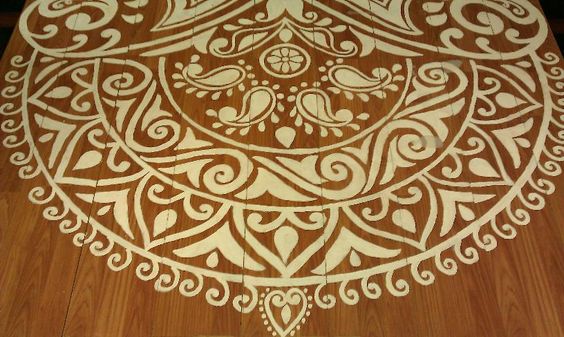
A half-circle motif, typically painted near the prayer alter or threshold | Image: Google
I remember, as a young kid, I would wake up early on the days of festivals, which ranged from Poila Boishakh to Durga Puja and Lakshmi Puja to Makar Shonkranti, and panic upon not seeing my Mother by my bedside. Wondering where she was, I would call out to her and she would call back, “Come, see what I’m making.”

I would track her voice either to the prayer room or to the front door and find her hunched over the threshold, paintbrush in hand and a bowl of white, viscous substance in front of her. What amazed me was the intricate painting she had made on the floor, complex networks of flowers, leaves, patterns, animals, birds, fishes seamlessly woven together to form a masterpiece.

Sometimes, Mom would use a piece of cotton instead of a paintbrush. As I watched, spellbound at her creativity, she would hand me the cotton-ball with a smile, “Your turn!” Sometimes, she would paint only the outlines, urging me to fill up colour in the shapes. Never would she try to correct me when I was being messy with my handiwork and practically ruining hers. She would even appreciate me for a job well done, when I got frustrated at the lack of artistic finesse in my work.
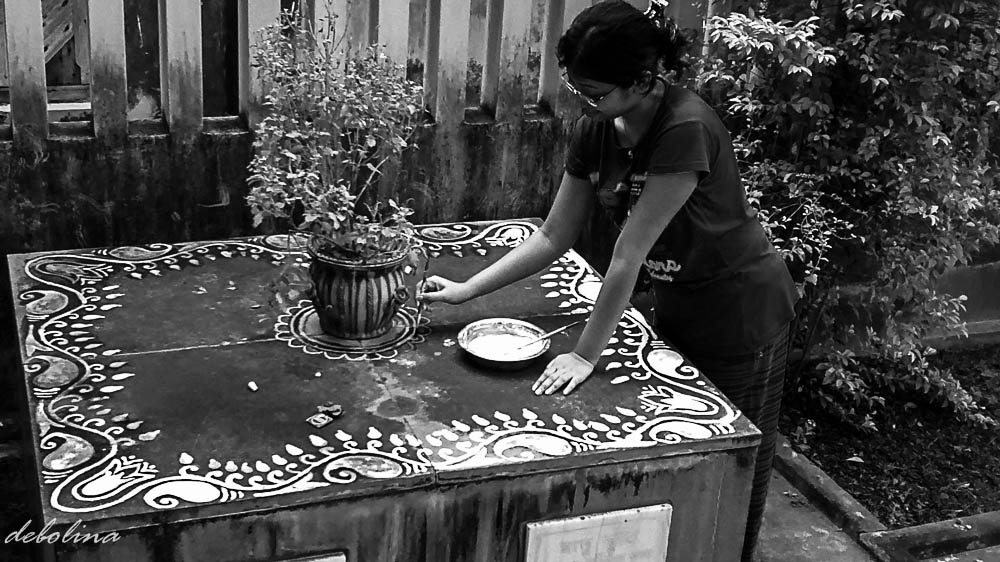
Years passed and eventually my painting skills improved. Before I had even realized it, Mom had entrusted me with the responsibility of painting Alpona during festivals. She would oversee my work and suggest changes when needed. She still does and I couldn’t be more grateful for her guidance.
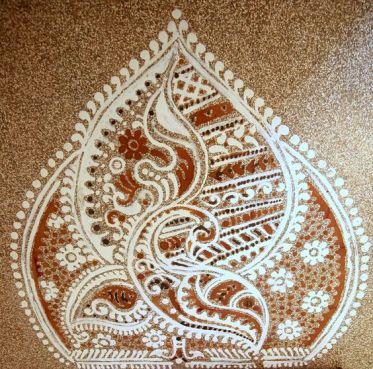
Alpona‘s etymology can be traced back to two Sanskrit words – ‘Alimpana’ and ‘Alipana’. While the former means ‘to plaster or coat with’, the latter refers to an old art of making embankments. Traditionally, the paint for Alpona has been made by mixing rice powder or rice paste with water; rice (anna) being perceived as a holy substance, a symbolic embodiment of wealth and prosperity. Sometimes, green, pink, yellow and red highlights would be added to the otherwise white motifs, the hues obtained from natural ingredients like leaves, flowers turmeric and vermilion (sindoor) respectively. Nowadays, chalk, fabric or acrylic colours are often used, with a dollop of glue in the mixture, to make the designs last longer.
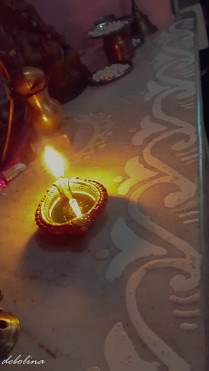
There are certain customs that are maintained while choosing the placement of the Alpona too, guidelines if you please. The intricate patterns and motifs are primarily used for adorning the altar or seat of the idols before the rituals of worship commence. It is much like how a king’s throne would be carefully designed to look grand, to fit a ruler’s majesty perfectly.
Another important area is the Tulsi-moncho . For thousands of years, the ‘Queen of Herbs’, Tulsi (Holy Basil) has been revered as one of the most sacred herbs in India, popular for its medicinal qualities. Hindus view the plant as a manifestation of goddess Lakshmi. Most households have a moncho or altar in their front-yard, dedicated to the plant, that is regularly decorated with Alpona. It is only after the alter and Tulsi-moncho have been embellished, do the painters move on to other parts of the house.
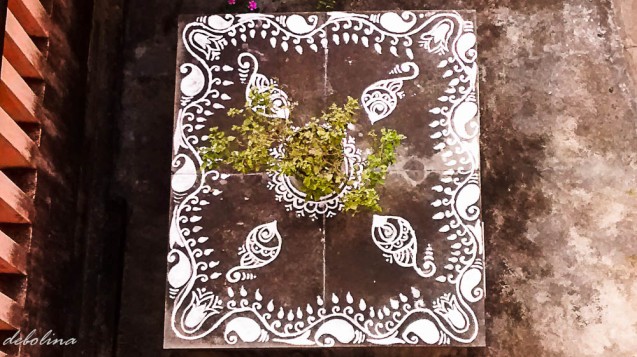
Tulsi-moncho adorned with Alpona
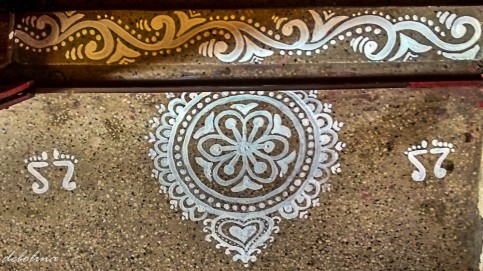
The doorstep is a must as it is the first place where the guests get a glimpse of how well one has decorated their home for a festival. Then there are the windowsills, courtyard and living area.
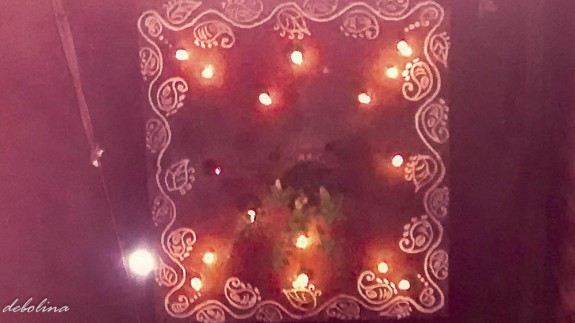
Alpona has evolved much over the centuries. It is understandable that what started out as a ritualistic custom, is today admired, even cherished, as an indigenous art form. For many, like me, it is heritage, something that binds me to my roots, something that I have inherited from my Maa, she from hers and so on. For others it is a medium of self-expression. No matter, its unique meaning to individuals, it is celebrated by Bengalees as an integral part of their festivals, something that holds the power to unite them across borders, just like Rabindra Sangeet. Love for this art form has been evidenced in Kolkata’s longest Alpona during Durga Puja…
…just like it has been reflected in world’s longest Alpona in Dhaka during Poila Boishakh.
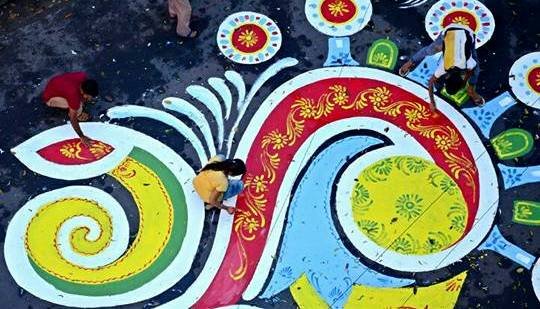
One Comment Add yours